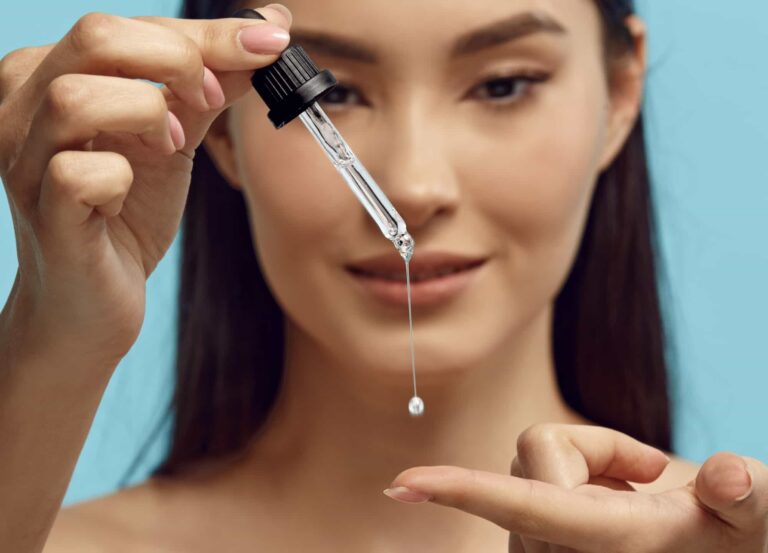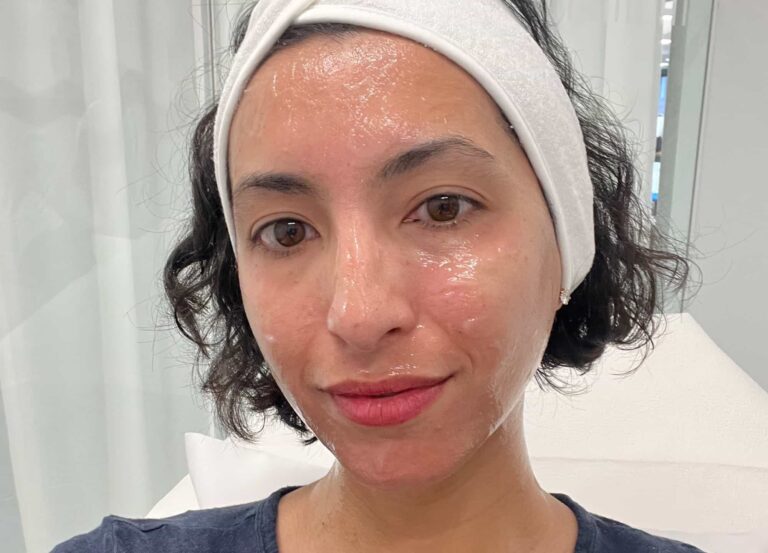In so many ways, the coronavirus pandemic altered our lives forever. One of the lasting changes it had is the shift to going entirely digital. Everything from work meetings to math class to happy hours moved to the screens of our mobile devices, as did medical appointments. And even though in-person doctor visits are no longer as scary or stressful as they were during the spring of 2020, telemedicine remains extremely popular. (Case in point: most health insurance companies started fully covering telemedicine appointments during the pandemic, and many insurance plans continue to do so.)
Thanks to telemedicine, thousands of doctors around the country—especially dermatologists and plastic surgeons—are able to help their patients with specific concerns from the comfort of their couch. And while it’s admittedly a very convenient option, when it comes to dermatology services, it’s important to keep in mind that there’s only so much that can be diagnosed through a screen. So we asked experts to narrow down what, exactly, can (and can’t) be done via teledermatology.
First off, what exactly is dermatology telemedicine?
“Telemedicine is video conferencing technology that allows patients to have virtual visits with providers through their cell phone or laptop from the safety of their own home, meaning they can continue dermatological care while also practicing social distancing,” explains Dr. Marguerite Germain, a board-certified dermatologist in Charleston, South Carolina. “Patients schedule a telemedicine appointment the same way they would schedule an in-office visit with us—over the phone or through online booking.” Prior to their appointment, Dr. Germain says, patients receive a reminder message that contains a link to their virtual waiting room. “They click on the link to sign in, and then their provider begins a video chat with them.” (Depending on your provider, they may also have you upload photos of your condition prior to your telehealth appointment.)
However, video chat is not always necessary. Some doctors—especially dermatologists—are able to diagnose and prescribe medication via photos and a list of symptoms, but that’s not the case for plastic surgeons. “Telemedicine can consist of a simple phone call, but since plastic surgery is very visual and being able to see the patient is a major part of the assessment, most plastic surgeons conduct their consultations in a video format,” says Dr. Konstantin Vasyukevich, a board-certified plastic surgeon in New York City.
What can dermatologists treat during a virtual appointment?
For dermatologists, any rashes or growths, including rosacea, acne, eczema, psoriasis, warts, and rashes, can be diagnosed and treated remotely. (Nail conditions, and some hair conditions, such as alopecia are also included on that list.) An important point to note is that not everything can be seen or treated through telemedicine, says Dr. Sonia Badreshia-Bansal, a board-certified dermatologist in Danville, California. “An in-office visit and evaluation continues to be the best option to limit misdiagnosis and mismanagement, especially as this area of medicine is becoming relatively the new norm,” she explains.
Telemedicine is a great tool when access is an issue, but it has limitations in proper diagnosis. “Nothing replaces an in-office diagnosis, especially if further tests are required, such as biopsy,” explains Dr. Badreshia-Bansal. In general, teledermatology is a great source for chronic and classic cases—the following included.
Rashes
“Allergic contact dermatitis is probably the most common rash I diagnose via telemedicine,” explains Dr. Germain. “The first course of action would be to prescribe a topical medication—but if the rash is severe, an oral medication might also be prescribed, in order to get it under control quickly.” Typically, Dr. Germain would prescribe medication, just to ensure that the rash is cleared up efficiently.
Rosacea
Rosacea is a chronic inflammatory skin condition on the face. While the exact cause is unknown, many factors can trigger the condition—including heat, sunlight, spicy foods, stress, alcohol, caffeine, and exercise.
When treating a patient for rosacea via telemedicine, Dr. Germain looks for typical rosacea symptoms, including redness, flushing, inflamed blood vessels, pustules, and papules. “I would look for these indicators in the patient’s skin while also taking into account their medical history,” she says.
While there is no cure for rosacea, a combination of lifestyle changes, topical products, and laser treatments can help manage the condition and its symptoms. “I might recommend certain redness-reducing skin-care products or prescribe topical medication during a telemedicine appointment and then would instruct the patient to follow up in a few months so we can monitor the progress and adjust the treatment as necessary,” says Dr. Germain.
Acne
Acne is a skin condition that occurs when the hair follicles become clogged with oil, dead skin cells, and bacteria. It is characterized by blackheads; pus-filled pimples; and even large, painful cysts. “To diagnose a patient with acne, I would evaluate their skin for these symptoms while also taking into account their medical history,” explains Dr. Germain.
When treating acne patients via telemedicine, the first order of business for Dr. Germain would be to recommend a skin-care regimen with products containing acne-fighting ingredients like salicylic acid and benzoyl peroxide. “I might also prescribe topical medications, and if the acne is more severe, I might even recommend oral medication,” explains Dr. Germain. “I would instruct the patient to follow up in about six weeks so we can see how they are progressing and prescribe further treatments as needed.”
Eczema
Eczema is a rash, usually from dry skin, irritation, or allergic reactions. “Typically, there is a history or family history of dry skin, asthma, or allergies with [eczema] outbreaks, especially in the cooler winter months, [so it’s easier to diagnose eczema based on a previous history with it],” says Dr. Badreshia-Bansal. “Hot spots can include hands, behind the knees, and the antecubital fossa [where the arm bends]. Right now, we may see it especially from overwashing [of] hands or frequent use of masks.”
To treat eczema, Dr. Badreshia-Bansal suggests moisturizing a lot, to both ameliorate and prevent outbreaks. “Use gentle cleansers, avoid scratching or rubbing, and avoid allergens and irritants whenever possible,” she says. If an eczema outbreak gets really inflamed, “sometimes we have to combine steroid creams and antihistamines,” explains Dr. Badreshia-Bansal.
Psoriasis
Psoriasis is an inflammatory autoimmune condition causing thick scaly plaques on the body in those with a genetic predisposition. “Chronic mild cases require topical steroids, regular follow-up, and counseling on prevention, which can be done via telemedicine,” says Dr. Badreshia-Bansal. “Moderate to severe cases should be seen in-office, as these patients may require injectables or oral medications that require close monitoring.”
Warts
A common virus found in the environment can cause warts in susceptible people. “You can acquire them from public places, or it can enter through cuts or abrasions in the skin, and they are commonly found to affect hands, elbows, and knees,” says Dr. Badreshia-Bansal. When correctly diagnosing warts via telemedicine, Dr. Badreshia-Bansal usually looks for a photograph showing a bump or several bumps in commonly distributed areas. “Some home treatments may help to improve them, but more effective therapies [ by freezing them] do require in-office visits. Over time, they will go away on their own, once the immune system kicks in to fight it off.”
In addition to treating the above conditions, doctors can give product recommendations and advice for skin-care-routine adjustments during the virtual appointment too. They can also discuss noninvasive and minimally invasive treatments, such as Botox, fillers, lasers, and body sculpting, with their patients via telemedicine but obviously can’t perform the treatments remotely. After discussing in-office treatments over video chat, patients will then have to make an in-person appointment to undergo the procedure.
Related: 10 Things to Know Before Having a Virtual Consultation With Your Derm or Surgeon
What are dermatologists unable to treat over video chat?
Doctors agree that there’s one thing that cannot be properly evaluated in a virtual appointment—skin cancer, including melanoma. According to Dr. Badreshia-Bansal, potentially cancerous moles can sometimes be diagnosed via telemedicine, but it’s really not an ideal method. “It’s best to come into the office for a diagnosis, in case further tests, such as a biopsy, [are] required,” she says.
Dr. Germain agrees that it’s not best to diagnose cancerous moles in a video chat. “The provider needs to have all the tools on hand to properly evaluate the [potentially cancerous] area and to collect a tissue sample, if necessary,” she says.
How do you obtain a prescription when diagnosed with a skin condition via video chat?
Getting a prescription via telemedicine is the same as obtaining one in-office. “I would prescribe medication during a telemedicine appointment the same way that I would during a regular appointment—the medication would be entered into our electronic medical record and called into the patient’s local pharmacy of choice,” explains Dr. Germain.











